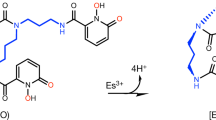Abstract
The conventional chemical definition of an alkali metal in solution is based on the tacit assumption of cation formation through the spontaneous ionization of the ns1 valence electron1. However, much experimental evidence, both direct and indirect, has accumulated over the past decade for the existence of the anionic form of the alkali elements in certain non-aqueous solutions2. In 1974, Ceraso and Dye3 reported the fingerprint nuclear magnetic resonance (NMR) spectrum of the sodium anion, Na−, which constituted the first direct proof of the existence of this ion in solution. Since then, high-resolution multi-element NMR spectroscopy has been used to identify the ubiquitous Na− ions4–7, as well as the rubidide (Rb−) (refs 4, 7) and caeside (Cs−) ions4 in a variety of metal solution systems both liquid and solid8,9. Until now, the status of the potasside ion, K−, has been unclear. We report here the first observation of the 39K-NMR spectrum of K− from solutions of potassium metal and potassium/caesium mixed metals in the liquid crown ethers, 1,4,7,10-tetraoxacyclododecane (12-crown-4, 12C4) and 1,4,7,10,13-pentaoxacyclopentadecane (15-crown-5, 15C5). This constitutes the first direct proof of the existence of K−; the NMR data also give detailed information on the microscopic electronic structure of the potassium anion in solution.
This is a preview of subscription content, access via your institution
Access options
Subscribe to this journal
Receive 51 print issues and online access
$199.00 per year
only $3.90 per issue
Buy this article
- Purchase on Springer Link
- Instant access to full article PDF
Prices may be subject to local taxes which are calculated during checkout
Similar content being viewed by others
References
Parish, R. V. The Metallic Elements (Longman, London, 1977).
Dye, J. L. Prog. inorg. Chem. 32, 327–441 (1984).
Ceraso, J. M. & Dye, J. L. J. chem. Phys. 61, 1585–1587 (1974).
Dye, J. L., Andrews, C. W. & Ceraso, J. M. J. phys. Chem. 79, 3076–3079 (1975).
Edwards, P. P., Guy, S. C., Holton, D. M. & McFarlane, W. JCS Chem. Commun. 1185–1186 (1981).
Edwards, P. P. et al. J. phys. Chem. 87, 4362–4363 (1983).
Holton, D. M. et al. JCS Chem. Commun. 740–741 (1984).
Ellaboudy, A. S., Tinkham, M. L., Van Eck, B., Dye, J. L. & Smith, P. B. J. phys. Chem. 88, 3852–3855 (1984).
Dye, J. L. & Ellaboudy, A. Chem. Br. 3, 210–215 (1984).
Dewald, R. R., Jones, S. R. & Schwartz, B. S. JCS Chem. Commun. 272–273 (1980).
Edmonds, R. N., Holton, D. M. & Edwards, P. P. JCS Dalton Trans. (in the press).
Poonea, N. S. & Bajaj, A. V. Chem. Rev. 79, 389–445 (1979).
Edwards, P. P., Ellaboudy, A. S. & Holton, D. M. Angew. Chem. Int. Ed. Engl. (submitted).
Dye, C. L., Andrews, C. W. & Mathews, S. E. J. phys. Chem. 79, 3065–3070 (1975).
Holton, D. M., Ellaboudy, A. S., Pyper, N. C. & Edwards, P. P. J. chem. Phys. (in the press).
Pyper, N. C. & Edwards, P. P. J. chem. Soc. (in the press).
Mendeléeff, D. I. The Principles of Chemistry 3rd edn (Longman, London, 1905).
Tinkham, M. L. & Dye, J. L. J. Am. chem. Soc. (submitted).
Author information
Authors and Affiliations
Rights and permissions
About this article
Cite this article
Edwards, P., Ellaboudy, A. & Holton, D. NMR spectrum of the potassium anion K−. Nature 317, 242–244 (1985). https://doi.org/10.1038/317242a0
Received:
Accepted:
Issue Date:
DOI: https://doi.org/10.1038/317242a0
Comments
By submitting a comment you agree to abide by our Terms and Community Guidelines. If you find something abusive or that does not comply with our terms or guidelines please flag it as inappropriate.



